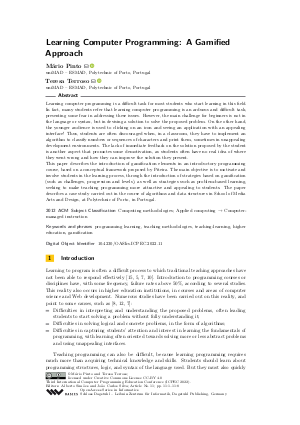Learning Computer Programming: A Gamified Approach
Authors
Mário Pinto  ,
Teresa Terroso
,
Teresa Terroso 
-
Part of:
Volume:
Third International Computer Programming Education Conference (ICPEC 2022)
Part of: Series: Open Access Series in Informatics (OASIcs)
Part of: Conference: International Computer Programming Education Conference (ICPEC) - License:
 Creative Commons Attribution 4.0 International license
Creative Commons Attribution 4.0 International license
- Publication Date: 2022-07-11
File

PDF
OASIcs.ICPEC.2022.11.pdf
- Filesize: 431 kB
- 8 pages
Document Identifiers
Subject Classification
ACM Subject Classification
- Computing methodologies
- Applied computing → Computer-managed instruction
Keywords
- programming learning
- teaching methodologies
- teaching-learning
- higher education
- gamification
Metrics
- Access Statistics
-
Total Accesses (updated on a weekly basis)
0PDF Downloads0Metadata Views
Abstract
Learning computer programming is a difficult task for most students who start learning in this field. In fact, many students refer that learning computer programming is an arduous and difficult task, presenting some fear in addressing these issues. However, the main challenge for beginners is not in the language or syntax, but in devising a solution to solve the proposed problem. On the other hand, the younger audience is used to clicking on an icon and seeing an application with an appealing interface! Thus, students are often discouraged when, in a classroom, they have to implement an algorithm to classify numbers or sequences of characters and print them, sometimes in unappealing development environments. The lack of immediate feedback on the solution proposed by the student is another aspect that promotes some demotivation, as students often have no real idea of where they went wrong and how they can improve the solution they present. This paper describes the introduction of gamification elements in an introductory programming course, based on a conceptual framework proposed by Piteira. The main objective is to motivate and involve students in the learning process, through the introduction of strategies based on gamification (such as challenges, progression and levels), as well as strategies such as problem-based learning, seeking to make teaching programming more attractive and appealing to students. The paper describes a case study carried out in the course of algorithms and data structures in School of Media Arts and Design, at Polytechnic of Porto, in Portugal.
Cite As Get BibTex
Mário Pinto and Teresa Terroso. Learning Computer Programming: A Gamified Approach. In Third International Computer Programming Education Conference (ICPEC 2022). Open Access Series in Informatics (OASIcs), Volume 102, pp. 11:1-11:8, Schloss Dagstuhl – Leibniz-Zentrum für Informatik (2022)
https://doi.org/10.4230/OASIcs.ICPEC.2022.11
BibTex
@InProceedings{pinto_et_al:OASIcs.ICPEC.2022.11,
author = {Pinto, M\'{a}rio and Terroso, Teresa},
title = {{Learning Computer Programming: A Gamified Approach}},
booktitle = {Third International Computer Programming Education Conference (ICPEC 2022)},
pages = {11:1--11:8},
series = {Open Access Series in Informatics (OASIcs)},
ISBN = {978-3-95977-229-7},
ISSN = {2190-6807},
year = {2022},
volume = {102},
editor = {Sim\~{o}es, Alberto and Silva, Jo\~{a}o Carlos},
publisher = {Schloss Dagstuhl -- Leibniz-Zentrum f{\"u}r Informatik},
address = {Dagstuhl, Germany},
URL = {https://drops.dagstuhl.de/entities/document/10.4230/OASIcs.ICPEC.2022.11},
URN = {urn:nbn:de:0030-drops-166158},
doi = {10.4230/OASIcs.ICPEC.2022.11},
annote = {Keywords: programming learning, teaching methodologies, teaching-learning, higher education, gamification}
}
Author Details
References
- Kirsti Ala-Mutka. A survey of automated assessment approaches for programming assignments. Computer Science Education, 15:83-102, June 2005. URL: https://doi.org/10.1080/08993400500150747.
- Yorah Bosse and Marco Aurelio Gerosa. Why is programming so difficult to learn?: Patterns of difficulties related to programming learning mid-stage. ACM SIGSOFT Software Engineering Notes, 41:1-6, January 2017. URL: https://doi.org/10.1145/3011286.3011301.
- Patrick Buckley, Seamus Noonan, Conor Geary, Thomas Mackessy, and Eoghan Nagle. An empirical study of gamification frameworks. Journal of Organizational and End User Computing, 31:22-38, January 2019. URL: https://doi.org/10.4018/JOEUC.2019010102.
-
Darina Dicheva, Christo Dichev, Gennady Agre, and Galia Angelova. Gamification in education: A systematic mapping study. Educational Technology & Society, 18:75-88, July 2015.

- Anabela Gomes, Cristiana Areias, Joana Henriques, and Antonio Mendes. Aprendizagem de programação de computadores: dificuldades e ferramentas de suporte. Revista Portuguesa de Pedagogia, 42:161-179, July 2008. URL: https://doi.org/10.14195/1647-8614_42-2_9.
- José Paiva, José Leal, and Ricardo Queiros. Authoring Game-Based Programming Challenges to Improve Students’ Motivation, pages 602-613. Advances in Intelligent Systems and Computing, Springer, January 2020. URL: https://doi.org/10.1007/978-3-030-11932-4_57.
- M. Pinto. Learning computer programming: The role of gamification. In EDULEARN18 Proceedings, 10th International Conference on Education and New Learning Technologies, pages 9492-9497. IATED, 2-4 july, 2018 2018. URL: https://doi.org/10.21125/edulearn.2018.2263.
- Martinha Piteira and Carlos Costa. Computer programming and novice programmers. In Proceedings of the Workshop on Information Systems and Design of Communication, pages 51-53, June 2012. URL: https://doi.org/10.1145/2311917.2311927.
- Martinha Piteira, Carlos Costa, and Manuela Aparicio. A conceptual framework to implement gamification on online courses of computer programming learning: Implementation. In Proceedings CISTI 2017, pages 7022-7031, November 2017. URL: https://doi.org/10.21125/iceri.2017.1865.
- Ricardo Queirós, Mário Pinto, and Teresa Terroso. Computer Programming Education in Portuguese Universities. In Ricardo Queirós, Filipe Portela, Mário Pinto, and Alberto Simões, editors, First International Computer Programming Education Conference (ICPEC 2020), volume 81 of OpenAccess Series in Informatics (OASIcs), pages 21:1-21:11, Dagstuhl, Germany, 2020. Schloss Dagstuhl-Leibniz-Zentrum für Informatik. URL: https://doi.org/10.4230/OASIcs.ICPEC.2020.21.
- Ricardo Queiros, Mário Pinto, Alberto Simões, and Filipe Portela. A Primer on Gamification Standardization, pages 1-13. IGI Global, January 2022. URL: https://doi.org/10.4018/978-1-7998-8089-9.ch001.
-
Jože Rugelj and Maria Lapina. Game design based learning of programming. In proceeding of International Scientific Conference Innovative Approaches to the Application of Digital Technologies in Education and Research (SLET-2019), May 2019.

- Alberto Simões. Using Game Frameworks to Teach Computer Programming, chapter 10, pages 221-236. IGI Global, January 2017. URL: https://doi.org/10.4018/978-1-5225-1034-5.ch010.
-
Jakub Swacha and Pawel Baszuro. Gamification-based e-learning platform for computer programming education. In X World Conference on Computers in Education, June 2013.

- Christopher Watson and Fred Li. Failure rates in introductory programming revisited. ITICSE 2014 - Proceedings of the 2014 Innovation and Technology in Computer Science Education Conference, June 2014. URL: https://doi.org/10.1145/2591708.2591749.
-
Kevin Werbach and Dan Hunter. For the Win: How Game Thinking can Revolutionize your Business. Wharton Digital Press, January 2012.

